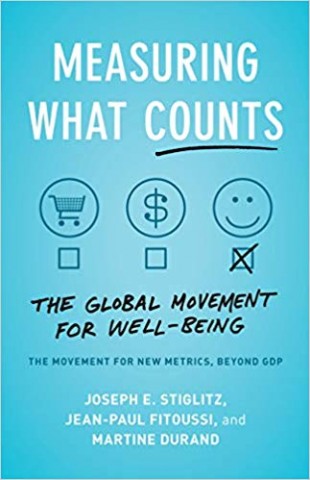Measuring What Counts
In "Measuring What Counts: The Global Movement for Well-Being" (2019), Stiglitz, Fitoussi and Durand build upon the work that was conducted following a 2009 commission to re-think what measures are used to assess the health of the economy (particularly GDP). The financial crises forced reflections on how the vulnerabilities were not understood; to which these authors say that most "fundamentally, policy-makers ignored these warning signals because of the ideological blinders that prevented them (and their economic advisors) from seeing the dangers ahead" (p. 6). The 2009 work was led by Stiglitz, Fitoussi and Sen and the results were published in the book "Mismeasuring Our Lives" (2010). Nearly a decade later, this book broadens the areas of work, summarizes progress made, and highlights areas that require much more work / research.
On metrics: "That GDP didn't do all that was hoped of it shouldn't be a surprise: no single number can summarize anything as complex as the economy" (p. 9). Yet, there is a slippery slope in metrics, some are usefully contextualized, but then not globally relevant, or vice versa. "There is some tension, though, between the desire to have metrics that reflect the particular situation within a country and the need to have metrics that enable cross-country comparisons, i.e., to give a picture of how a country is doing relative to others. Both perspectives are important: we all want to know how well we are doing (in one dimension or another) relative to our past or relative to what is occurring everywhere" (p. 19). The authors conclude, on this tensions that "more needed to be done at the international level" (p. 19).
On inequality: First, we need to do a better job understanding the multiplication / layering of vulnerability, rather than as stand-alone metrics: "Many of these inequality indicators are correlated, with the same households or individuals experiencing disadvantage in many of these dimensions. The report argued that one should focus on the household (or even better, the individual) as the unit of analysis, looking at all the dimensions that affect well-being at the same time" (p. 67). Second, we do not have the data, nor even the definitions for the data, to provide a basis for these understandings: "Some of the criteria for comparing horizontal inequalities across countries also lack well-established statistical conventions and definitions. An example is provided by disability status where, despite decade-long discussions, no generally accepted definition applied across official surveys exists yet. In other cases, no statistical criteria exists simply because these types of horizontal inequalities (for example, those linked to sexual orientation) have only recently entered public discussions" (p. 83-84). Even more challenging, they are, is assessing inequality of opportunity, not only outcomes (p. 88). How to do that? The authors recommend that: "Data should be disaggregated by age, gender, disability, sexual orientation, education, and other markers of social status in order to describe group differences in well-being outcomes; and metrics to describe within-household inequalities, such as those related to asset ownership and the sharing of resources and financial decisions within the household, should be developed." (p. 156)
On trust: "If the measures we rely on are out of sync with how citizens experience their lives, a lack of trust in government will develop" (p. 9). Later, they continue, "trust is negatively correlated with income inequality. And rising income inequality has also been related to lower trust in institutions. High-trusting societies have lower levels of income inequality, measured by Gini coefficients, while low-trusting societies show typically higher levels of income inequality. Trust is undermined by things that run against people's sense of fairness. Since, at least in many countries, there is a general sense that income is inequitably distributed, it is not a surprise that economic equality is consistently identified as one of the strongest predictors of generalized trust, and that countries with highest levels of trust rank highest on economic equality (e.g. Nordic countries, the Netherlands, Canada; OECD, 2018a)." (p. 126)
When you subscribe to the blog, we will send you an e-mail when there are new updates on the site so you wouldn't miss them.

